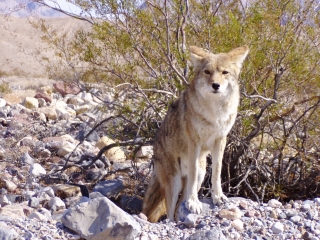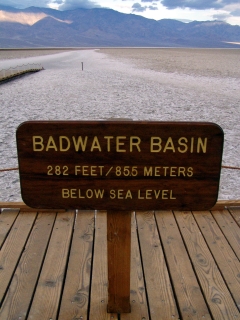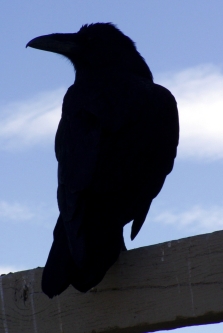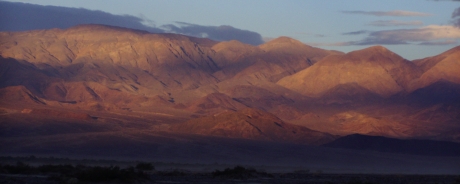NPS Website; Local Website
 WHAT IS IT?
WHAT IS IT?At 3.4 million acres, Death Valley NP is the largest National Park in the lower 48 states. The Park also contains the hottest and lowest place in the Western Hemisphere, Badwater Basin, at 282 feet below sea level.
BEAUTY (7/10)
Death Valley NP is a scary place. It is barren, sandy, sweltering and horribly windy. There is no green here, instead the desert confronts you with myriad shades of tans, yellows, whites and dulled purples. A constant haze sits over the valley even in the cooler months of October. If you dare get out of your car, the wind whips the sand into your face.
The main roads travel in areas mostly below sea level. The horizon reveals imposing mountains surrounding you in every direction. Among them Telescope Peak (11,049 feet) to the west, Funeral Peak (6,384 feet) to the south, Pyramid Peak (6,703 feet) to the east and Tin Mountain (8,953 feet) to the north. There is no way out of this.
The actual beauty of the badlands desert formations, the sand dunes, the canyons and the mountain peaks was hard to take in. We were preoccupied with our own discomforts and our own fears.
HISTORICAL INTEREST (3/10)
There is the inevitable tragic tale of pioneer travelers who strayed off course and into the Death Valley inferno. There’s also an impossibly cluttered Borax mining museum run by the fine folks from Xanterra that commemorates the minimal amount of mining that happened in this desert wasteland. Death Valley NP’s history amounts to a few ghost towns, abandoned mines and one Moorish-style vacation home built in the 1930’s, Scotty’s Castle.
CROWDS (5/10)
There are few places for people to congregate at Death Valley NP despite its imposing acreage. During our visit, those few places, Scotty’s Castle, the Furnace Creek Visitor Center and the Furnace Creek Ranch Bar, were all teeming with tourists. Scotty’s Castle proved the most difficult. Tours had filled for hours in advance. Manned only by a volunteer, the single file line for tickets swelled to 20 deep. It was 15 minutes before we reached the overwhelmed young man.
A large crowd of motor bikers and golfers (yes, there is a golf course in the Park) joined us at the Furnace Creek Ranch Bar to watch a Red Sox-Yankees playoff game. They were all staying in the Xanterra run Furnace Creek Inn and Ranch, a 4-star resort. We overheard members of both parties reveal that they were so sick of Death Valley that they had spent the day in Las Vegas, Nevada some 150 miles to the southeast.
 EASE OF USE/ACCESS (1/5)
EASE OF USE/ACCESS (1/5)Do not be fooled. Death Valley NP is deceptively huge and in the middle of nowhere. The valley is surrounded by mountains and all roads descend from 4,500 foot+ passes. The western entrance descends twice into the sea level Panamint Valley then up through the 4,956 foot Towne Pass and then dips into the below sea level Death Valley. It is a steep, roller coaster ride hard on the brakes and especially forbidding. If your car finds trouble, good luck.
The Park’s southern entrance is 60 miles from Baker, California and Interstate 15. However, the first attraction, the lowest point in the Western Hemisphere, Badwater Basin, is 60 more miles northward. The Park’s Visitor Center is another 20 miles to the north. Yes, the Visitor Center is located smack dab in the center of the Park. Its location makes no sense. The VC is 80 miles from the south entrance, about 80 miles from the west entrance, 60 miles from the north entrance and 40 miles from the east entrance.
Do not enter from the Park’s fifth and final entrance, the southeast. Why? Because a recent flash flood completely destroyed the road. We don’t mean a few potholes. The road looks as if a massive earthquake has swallowed it. The concrete juts up a jagged angles, in one place completely submerging a port-o-potty. (Insert joke here) We had no idea that rain could be so destructive. As a result, there is no access to Zabriskie Point and Artists View, two popular attractions and a setting for the controversial 1971 Michelangelo Antonioni film, Zabriskie Point.
If you do not have a 4x4 vehicle, your Park access is further limited. A good portion of the roads are unpaved. For example, Death Valley NP landmark, the Racetrack, is located 35 miles down one of these roads. We were out of luck. Not just because the Nissan Altima is the opposite of high clearance but the flash flood also destroyed the road to the Racetrack. The Death Valley NP website provides to-the-day information about road closings.
We almost forgot about the weather. The Park newspaper reads, “By May, the valley is too hot for most visitors.” The AVERAGE July high is 115º F. Don’t come here in summer, there is no shade. We overheard a Ranger say that most of the summer tourists are Europeans who do not comprehend the oppressive heat and try to visit regardless. That’s kind of funny.
CONCESSIONS/BOOKSTORE (3/5)
We could see the books at Scotty’s Castle; we just couldn’t get to them. The line for tour tickets took up all available space. If one were able to browse, find interest in a book and want to purchase it, you would have to squeeze to the end of the line, the same one to purchase tour tickets and wait and wait and wait.
Space and selection were much better at the VC.
 COSTS (1/5)
COSTS (1/5)Death Valley NP costs $10 per vehicle, free with the National Parks Pass. The only indoor attraction in this sweltering terrain is Scotty’s Castle, a garish Moorish-style mansion. Living history tours of the house cost an amazing $8 per person and no discount with the Parks Pass. Nobody of any importance lived here, the place was a wealthy retreat built through the skillful work of a two-bit con artist named Scotty. For $8 combined, you could tour the homes of Teddy Roosevelt in Long Island, New York, Harry Truman in Independence, Missouri and Abe Lincoln in Springfield, Illinois. We did not go on the tour.
The Park should also be ashamed that it charges for its appallingly bad campsites, a few of which are actual parking lots. There is no shade, no wind protection and no tangible amenities. If you are not sleeping inside a car, do not plan on camping in Death Valley NP.
RANGER/GUIDE TO TOURIST RATIO (1/5)
We did not encounter a Ranger until after driving almost 150 miles within the National Park. The three Ranger stations were unmanned, and the pamphlet holder devoid of park brochures. We had no idea where we were and what we were supposed to see!
TOURS/CLASSES (3/10)
The Museum at the Furnace Creek Visitor Center is a rambling Mission ’66-era, non-interactive paneled affair. It is a shame that the one million people that drive hundreds of miles and brave the tyrannical heat are greeted with forty-year old exhibits. The print is even fading on many of the panels. We found it hard to concentrate in loud, one-room, open-space museum.
The most interesting exhibit we found was at Badwater Basin showing the lowest and hottest places in the world. Michael silently checked off the places in his head and imagined, “can’t wait to go there” and “it would be wonderful to go there.” Gab thought, “There is no way I’m going to any of those places. Get me out of the desert now.”
The Museum at Scotty’s Castle consists of a few panels explaining the history of the house. The exhibits only reinforced our doubts: “why would we want to tour it?” Perhaps the $8 guided tour of Scotty’s Castle is a gem. We don’t know. Our budget limits our trip to important places. The most interesting part of the Scotty’s Castle Museum was the photography display of the recent flash flood’s aftermath. There is a similar exhibit of the incredible destruction at Furnace Creek.
FUN (2/10)
Highlights of a day in Death Valley: 1) realization that the direct road to Las Vegas was out of commission; 2) complete thankfulness that we had a full tank of gas after seeing $3.09 per gallon prices; 3) no Rangers and no Park brochures anywhere; 4) Gab, “oh my heavens, that campsite is a parking lot”; 5) Michael, “No way am I hiking up another sand dune; 6) Gab, “$8 for a tour of that ugly house!”; 7) a seemingly tame coyote standing in the middle of the road refusing to cede the way; 8) purchasing a campsite at 1:00pm, seeing the $8 Scotty’s Castle tour fee and then realizing that we’d have nothing to do in this pit of nothingness until bedtime; 9) ditching the campsite and traveling southward; 10) escaping the outside at the Furnace Creek Ranch Bar; 11) weathering the hot night with 50mph+ winds nearly lifting up our tent (with us in it) every five minutes.
We could not wait to leave.
 WOULD WE RECOMMEND? (2/10)
WOULD WE RECOMMEND? (2/10)If you don’t mind traveling miles out of your way to see geographic extremes then, of course, come to Death Valley. Everything that the Park offers - scenery, hikes, mountain climbing, stargazing, bird watching, house tours, sand dunes, camping, off-roading, escaping to a desert resort, golfing – can be done at nearby parks and resorts with more stunning results and much less hassle. Death Valley NP is more trouble than it is worth.
TOTAL 28/80
www.usa-c2c.com
© 2004-06